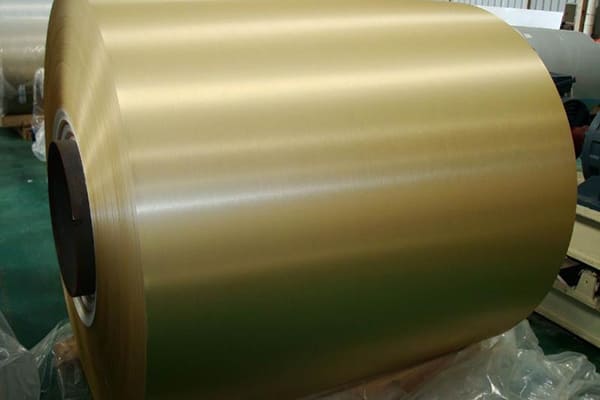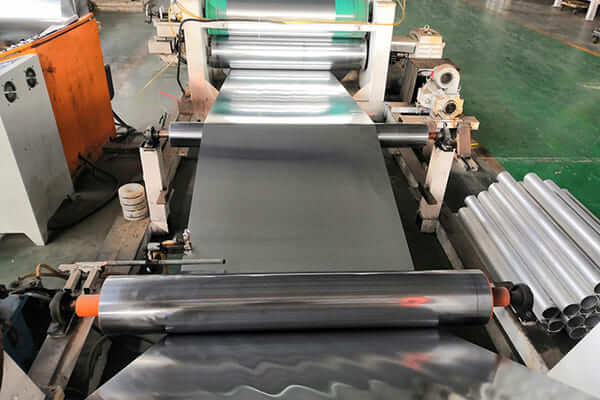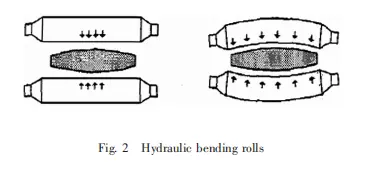Sigaralar için alüminyum folyonun haddelenmesi sürecinde, haddehane çalışma merdanesinin pürüzlülük ve dışbükeylik proses parametreleri, alüminyum folyo ürünlerinin kalitesini etkileyen belirleyici faktörlerdir
Aluminum foil is light in weight and exhibits excellent properties in terms of corrosion resistance, nem direnci, and UV resistance. It is also recyclable, easy to bend and print, and has good thermal stability. Öyleyse, it is widely used in cigarettes, ilaç, household, elektronik ve diğer alanlar. Using aluminum foil packaging: ① Save a lot of resources; ② Improve the grade and aesthetics of packaging, thereby effectively promoting the consumption and application of aluminum foil.

Aluminum foil for cigarettes
Cigarette packaging is a very important part of cigarette production and the last process. In the entire process of cigarette production, circulation and consumption, the quality of packaging materials plays a very important role in maintaining the quality of cigarette products, promoting consumption, and guiding consumption. Compared with other commodities, cigarette packaging materials require greater specificity, no odor, should be non-toxic and harmless to the human body, and should have moisture resistance and isolation properties. Aluminum foil has all the properties required for cigarette packaging. In the process of application in the cigarette industry, it is often supplied with a thickness of (6~6.5) μm. In the subsequent process, it needs to go through many steps such as compounding, boyama, pressing, Kurutma, vb. to finally form qualified packaging materials. In order to ensure the yield rate of the subsequent compounding step, the quality of the aluminum foil raw material must meet the indicators, especially the plate shape of the aluminum foil must be straight, so as to avoid wrinkling during compounding, resulting in broken strips and serious economic losses.
The rolling of aluminum foil is quite special, especially in the middle and fine rolling stage, the thickness of the aluminum foil is very small, and the size reaches the micron level. By increasing the pressure during the rolling process, the rollers are elastically deformed and the rolled material is plastically deformed, and the latter is more likely to occur. Once the rollers are elastically flattened, it must be taken seriously because it will seriously affect the rolling process of the aluminum foil. Genel konuşma, aluminum foil is rolled seamlessly, and the micron-level thickness is achieved by controlling the unwinding tension parameters and rolling speed parameters. Yuvarlanma işlemi sırasında, the changes in the rolling process influencing factors will determine whether the quality of the tobacco foil products is qualified and whether it meets customer requirements. There are many process influencing factors in the rolling process, mainly rolling oil, working rolls, plate shape control, and the quality of the original plate shape of the supplied billet. Öyleyse, a systematic study of the process influencing factors of the finishing rolling process in tobacco aluminum foil has important guiding significance for the finishing rolling production process control in other aluminum foil products.
The electrolytic aluminum casting and rolling selected for the test is an aluminum foil blank for cigarettes. The chemical composition is 1235 alaşım. The aluminum foil blank specification is (0.24×1350) mm. The test quantity is 50 t, the number of test rolls is 16, and the composition of 1235 alloy is shown in Table 1.
| 1235 Alloy Chemical Composition Table | ||||||||
| Si | Fe | Cu | Mn | Mg | çinko | Nın-nin | V | Al |
| 0.12~ 0.15 | 0.38~0.42 | 0.01~0.02 | ≤0.003 | ≤0.003 | ≤0.02 | 0.01~0.03 | ≤0.01 | kenar boşluğu |
The test equipment mainly includes the German Achenbach 1400 mm medium finishing mill, pinhole box, online plate shape detector, and online surface detection equipment.
In order to study the process influencing factors, action mechanisms and countermeasures in the process of medium and fine rolling of aluminum foil for cigarettes, this experiment set up 4 research schemes, and the final rolling thickness of the product was 0.006 mm:
2.1.1 Analysis of the impact on product quality
During the fine rolling production process of electrolytic aluminum casting and rolling tütün alüminyum folyo, the main functions of rolling oil include lubrication and cooling. Changes in the ratio of rolling oil, the purity of rolling oil, the use process of rolling oil, vb. will affect the quality of tobacco aluminum foil products, making it difficult to ensure the quality of tobacco aluminum foil products, and in severe cases, causing scrapping. The final thickness of tobacco aluminum foil products is 0.006 mm. To achieve stable rolling and uniform product thickness, efficient process lubrication and matching friction coefficient are effective measures to control the minimum rollable thickness of aluminum foil. The rolling of tobacco aluminum foil has stricter requirements on the minimum rollable thickness, which is a prerequisite for producing tobacco aluminum foil products with qualified thickness. Improving the lubrication capacity of rolling oil is mainly achieved by adjusting the ratio of rolling oil.

In addition to the fact that the addition ratio of rolling oil will affect product quality, the purity of rolling oil and the use process of rolling oil will also have a great impact on the quality of tobacco aluminum foil products. During the fine rolling production process of aluminum foil for tobacco, it is generally easy to mix with mechanical hydraulic oil and oil mist, other mechanical oils, vb. Bu durumda, the purity of the rolling oil is greatly affected, and its physical and chemical properties are very likely to change, thereby affecting the rolling of aluminum foil for tobacco, resulting in the inability to guarantee product quality.
The rationality of the rolling oil use process is the key control factor to ensure the online plate shape and surface quality of aluminum foil products for tobacco. Its use process parameters mainly include rolling oil temperature, rolling oil pressure and rolling oil flow. Whether the setting is reasonable directly determines whether the aluminum foil products for tobacco can be rolled into finished products.
2.1.2 Control measures
By adding a certain ratio of alcohol, acid and ester to the rolling oil base oil, the oil film strength of the rolling oil can be improved. Böyle, a uniform and appropriate oil film thickness can be obtained. Practice shows that the more suitable addition ratio is that the alcohol is controlled at (7.0-8.0) mgKOH/g, the acid control value is ≤1.4 mgKOH/g, and the ester is controlled at (5.5-6.5) mgKOH/g.
By regularly measuring the physical and chemical properties of the rolling oil and monitoring the performance indicators of the rolling oil, the performance indicators of the rolling oil are prevented from changing and affecting the rolling of aluminum foil products for cigarettes. Aynı zamanda, relevant regulations on rolling oil filtration are formulated to ensure that the rolling oil is filtered and purified on schedule. During the filtration and purification, the rolling mill is not allowed to start production to prevent the reflux of dirty oil.
For the rolling of aluminum foil for cigarette packaging, the oil temperature control parameters of the rolling oil in the intermediate and fine rolling are different. In the intermediate rolling process, the best process parameter range of the rolling oil temperature is (30-40) °C, the rolling oil pressure is stably controlled at (4.0-5.0) Çubuk, and the oil flow is accurately controlled at 50%-60%; in the fine rolling process, the best process parameter range of the rolling oil temperature is (45-50) °C, the rolling oil pressure is stably controlled at (4.5-5.0) Çubuk, and the oil flow is accurately controlled at 45%-50%. Aynı zamanda, the use of rolling oil should be monitored and recorded. If the rolling oil quality cannot meet the rolling production of aluminum foil for cigarettes, the rolling oil can be replaced.
2.2.1 Analysis of the influence of process parameters on product quality
Sigaralar için alüminyum folyonun haddelenmesi sürecinde, haddehane çalışma merdanesinin pürüzlülük ve dışbükeylik proses parametreleri, alüminyum folyo ürünlerinin kalitesini etkileyen belirleyici faktörlerdir, especially for aluminum foil products for cigarettes, whose rolling thickness is generally controlled at (0.006~0.007) mm, and the roughness and convexity technical parameters of the rolling mill working roll are required to be higher. In the actual production process of aluminum foil for cigarettes, the roughness of the rolling mill working roll should be ensured to be uniform in the grinding process to avoid the inconsistency of the roughness of the upper and lower working rolls, which will cause the rolling process to slip and the rolling production to be unable to be realized. Aynı zamanda, the roughness parameters of the rolling mill working roll should be precisely controlled, and the roughness should not be too high, because too high will cause the fine defects on the surface of the product to expand during the rolling of the aluminum foil for cigarettes, forming pinhole-shaped defects, which is prone to belt breakage. Ek olarak, if the surface roughness of the working roll is too high, the surface finish of the aluminum foil product will not be enough, which cannot meet the customer’s use requirements. If the roughness of the working roll of the rolling mill is too low, the rolling speed of the rolling mill will be slow, which greatly reduces the production efficiency.
The crown process parameters of the working roll of the rolling mill have a great influence on the plate shape of the aluminum foil products for cigarettes. Genel konuşma, the crown setting of the working roll is different according to the requirements of the width of the product. In the actual production process, the roll shape of the working roll is changed by hydraulic roll bending. Hydraulic roll bending mainly involves the hydraulic cylinder applying hydraulic roll bending force to the working roll of the rolling mill, so that the working roll has a certain additional deflection, realizing the crown change of the working roll to compensate for the changes in the roll shape of the working roll during the rolling process, as shown in Figure 2.

Hydraulie bending rolls
2.2.2 Control measures
During the rolling process of aluminum foil for cigarettes, the roughness and convexity process parameters of the rolling mill working rolls are the decisive factors affecting the quality of aluminum foil products. Through the study of the roughness and convexity process parameters of the rolling mill working rolls, it is determined that in the production process of aluminum foil for cigarettes, the roughness of the rolling rolls in the rough rolling stage is stably controlled at (0.2-0.3) μm, the roughness of the rolling rolls in the intermediate rolling stage is stably controlled at (0.20-0.25) μm, and the roughness of the rolling rolls in the finishing rolling stage is stably controlled at (0.03-0.05) μm, which greatly improves the stability of the rolling process of aluminum foil for cigarettes and improves the quality of aluminum foil for cigarettes. Aynı zamanda, in the rolling production process of aluminum foil for cigarettes, in addition to ensuring the uniformity of the roughness of the rolling mill working rolls and timely adapting to the convexity changes of the working rolls, the lubrication system should also be improved to reduce the friction coefficient, increase the back slip of the deformation zone, and reduce the rolling force.
2.3.1 Analysis of the impact of plate shape control on plate shape
In the rolling production process of aluminum foil for cigarettes, the plate shape is a very critical technical indicator of the aluminum foil product itself, which determines the subsequent performance of the aluminum foil. There are three main ways to control the shape of aluminum foil products: ① hydraulic roll bending; ② hydraulic automatic thickness control system; ③ segmented cooling of rolling oil. The hydraulic roll bending and hydraulic automatic thickness control systems mainly make timely adjustments based on the characteristic changes during the rolling process of aluminum foil products, and the control effect is relatively average. The third control method uses segmented cooling of the rolling oil. Through the automatic detection system of the plate shape, the signal of the plate shape change is fed back in time to achieve closed control. For the rolling of wide-width aluminum foil products for cigarettes, this control method is more effective. With.
2.3.2 Control measures
In the general production process, according to the plate shape accuracy requirements of aluminum foil products for cigarettes, by adopting a complete lubrication process system, the plate shape of aluminum foil products can be better controlled. Aynı zamanda, the edge spray system can well prevent edge tightness during the aluminum foil rolling process and eliminate the problem of fire in the rolling mill.
In addition to the above, in the rolling production process of aluminum foil for cigarettes, reasonable reduction process parameters are also an important factor in ensuring the plate shape. If the reduction amount is set too large, it will cause the aluminum foil to wrinkle during rolling, and even affect the rolling of the lower link. Ağır vakalarda, the rolling strip will break, affecting production efficiency and product quality. If the set reduction amount is too small, the pass processing rate will increase and the production cost will increase. Öyleyse, reasonable control of the reduction amount according to the rolling conditions of the product is crucial to product rolling production and product quality assurance.
2.4.1 Analysis of the impact of the original plate type on subsequent medium and fine rolling
The supply of billets for the production of tobacco aluminum foil mainly includes two types: hot-rolled materials and cast-rolled materials. Regardless of the type of billet, the product quality of the incoming materials should be guaranteed, including the quality requirements of alloy composition, plate type, organization, verim, yüzey, vb., to meet the subsequent rolling production of tobacco aluminum foil products. In the actual production process, during the smelting process, the alloy composition is the first quality control factor. Birinci, the chemical composition must meet the technical requirements. Ikincisi, the refining process should be adopted to strictly control the hydrogen content and non-metallic slag inclusions in the aluminum liquid. Genel olarak, the hydrogen content is ≤0.12 ml/100Al, and the non-metallic slag inclusions above 5 μm are 0 to ensure the metallurgical quality, so as to meet the pinhole requirements of the subsequent finished tobacco aluminum foil. Aynı zamanda, the uniformity of the grain structure of the billet and the number of second-phase compounds should be guaranteed as much as possible to meet the performance requirements of subsequent products. For the incoming material shape of aluminum foil billets, because the shape is hereditary, if the incoming material shape is poor, the subsequent rolling shape will also be poor. Öyleyse, controlling the incoming material shape is critical to the subsequent rolling shape of tobacco aluminum foil.
2.4.2 Control measures
For billets for tobacco aluminum foil production, in the casting and rolling production link, the convexity and transverse and longitudinal thickness difference of the cast and rolled plate must be guaranteed. The convexity is generally controlled at 0% ile 1%, the longitudinal thickness is controlled within 0.05 mm/100 mm, and the transverse slope is controlled within 0.03 mm/100 mm. In the cold rolling production link, it is necessary to ensure that 98% of the strips have an online straightness of ≤10I.
This article mainly analyzes the process influencing factors and mechanism of cigarette aluminum foil in the intermediate and finishing rolling process, focusing on the impact of rolling oil products, different work roll process parameters, different plate shape control methods, and the original quality of aluminum foil blanks on product quality. darbe, control measures have been formulated. In the actual production of aluminum foil products for cigarettes, corresponding control measures have been adopted, with significant results. The quality of aluminum foil products for cigarettes has been greatly improved. The average product yield has reached 88%, which has improved production efficiency and reduced production costs.
5754 alüminyum bobin tipik bir Al-Mg element alaşımıdır, alüminyum-magnezyum pas geçirmez alüminyum plakaya ait.
Huawei Aluminium, 0,5 mm alüminyum bobinler için güvenilir ortağınızdır, ve geniş yelpazedeki alaşım modelleri ve özellikleriyle alüminyum ihtiyaçlarınızı karşılamaya kararlıyız..
Elektronik alüminyum folyo, bir dizi haddeleme işlemiyle işlenen bir tür alüminyum folyodur., yüksek saflıkta alüminyum külçelerin temizleme ve kesme işlemleri. Alüminyum elektrolitik kapasitörlerin üretimi için önemli bir hammaddedir..
Petek alüminyum folyo, alüminyum petek çekirdek olarak da bilinir, bir dizi altıgen hücre oluşturacak şekilde birbirine bağlanmış iki alüminyum folyo tabakasından yapılmış bir tür hafif çekirdek malzemedir., petek gibi.
Huawei Alüminyum alüminyum diskler yaygın olarak Gana'ya ihraç edilmektedir, Guatemala, Burkina Faso, Cezayir, Togo, Kenya, Nijerya, Güney Afrika, Fas ve diğer Afrika ülkeleri; Birleşik Arap Emirlikleri, Yemen, Katar, Kuveyt, İran, Ürdün, Suudi Arabistan ve diğer Orta Doğu ülkeleri.
Ağır hizmet tipi alüminyum folyo ekstra güç ve yırtılma direnci sağlar. Birçok aşçı pişirmek için kullanır, ızgara, ve depolama. İşaretli çoğu folyo rulosu "Ağır" arasında 0.0008" ve 0.001" kalın, ulusal birimlerde kabaca 0.02032-0.0254mm
No.52, Dongming Yolu, Zhengzhou Belediyesi, Arjantin, Çin
Henan Huawei Alüminyum Co, Ltd Şti, Çin Henan'daki En Büyük Alüminyum Tedarikçilerinden Biri,Biz 2001 Yılında Kurulduk, Ve ithalat ve ihracat ve yüksek kaliteli alüminyum ürünler konusunda zengin deneyime sahibiz
Pzt – Ctst, 8– 5PM
Pazar: Kapalı
No.52, Dongming Yolu, Zhengzhou Belediyesi, Arjantin, Çin
© Telif hakkı © 2023 Henan Huawei Alüminyum Co, Ltd Şti
son Yorumlar
Sayın Bay, Please offer your best FOB Prices specs are as under ALUMINIUM STRIP (AL=99.50% MIN) BOYUT:450 X32 X6 AA. SENİN BİRİN 570 TR-AW 1050 A, MİKTAR=3400KG
Merhaba, Aşağıdaki gibi öğe teklif etmek için çok nazik olur musunuz?: Bobin 0,6х1250 (1000)mm EN AW-3105 5tons
Merhaba, Bana Alüminyum plakalar sunabilir misiniz?? Aslında ihtiyacım var: 110mm x 1700mm x 1700mm 5083 H111 - 21 pcs Next year planed is 177 Adet
Harika makale. çok sevindim, bu makaleyi buldum. Birçok insan görünüyor, hakkında kesin bilgiye sahip olduklarını, ama çoğu zaman değil. Bu yüzden benim hoş sürprizim. etkilendim. Burası kesinlikle tavsiye edeceğim ve daha sık geri geleceğim, yeni şeyler görmek için.
alüminyum şerit gereksinimi